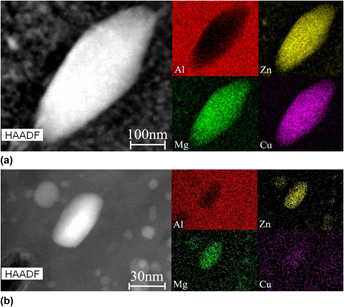Crossref Citations
This article has been cited by the following publications. This list is generated based on data provided by
Crossref.
Lin, Y C
Jiang, Yu-Qiang
Liu, Guan
and
Qin, Shengfeng
2018.
Modeling the two-stage creep-aging behaviors of an Al-Cu-Mg alloy.
Materials Research Express,
Vol. 5,
Issue. 9,
p.
096514.
Paulisch, M.C.
Treff, A.
Driehorst, I.
and
Reimers, W.
2018.
The influence of natural aging and repeated solution annealing on microstructure and mechanical properties of hot extruded alloys Al 7020 and Al 7175.
Materials Science and Engineering: A,
Vol. 709,
Issue. ,
p.
203.
Lin, Y.C.
Peng, Xiao-Bin
Jiang, Yu-Qiang
and
Shuai, Ci-Jun
2018.
Effects of creep-aging parameters on aging precipitates of a two-stage creep-aged Al–Zn–Mg–Cu alloy under the extra compressive stress.
Journal of Alloys and Compounds,
Vol. 743,
Issue. ,
p.
448.
Lin, Gaoyong
Song, Weiyuan
Feng, Di
Li, Kun
Feng, Yongping
and
Liu, Jinxia
2019.
Study of microstructure and mechanical property heterogeneity throughout the wall thickness of high strength aluminum alloy thick-wall pipe.
Journal of Materials Research,
Vol. 34,
Issue. 15,
p.
2736.
Shahriyari, Fatemeh
Shaeri, Mohammad Hossein
Bavarsiha, Fatemeh
and
Noghani, Mohammad Talafi
2019.
Creep behavior of solid solutioned and annealed Al-7075 alloy processed by equal channel angular pressing.
Materials Science and Engineering: A,
Vol. 765,
Issue. ,
p.
138225.
Chen, Xueying
Zhan, Lihua
Ma, Ziyao
Xu, Yongqian
Zheng, Qiang
and
Cai, Yixian
2020.
Study on tensile/compressive asymmetry in creep ageing behavior of Al–Cu alloy under different stress levels.
Journal of Alloys and Compounds,
Vol. 843,
Issue. ,
p.
156157.
Lin, Y.C.
Wu, Qiao
He, Dao-Guang
Zhu, Xu-Hao
Liu, Dan-yang
and
Li, Xin-He
2020.
Effects of solution time and cooling rate on microstructures and mechanical properties of 2219 Al alloy for a larger spun thin-wall ellipsoidal head.
Journal of Materials Research and Technology,
Vol. 9,
Issue. 3,
p.
3566.
Wang, Zheng
Wang, Shaogang
Zhang, Chengcong
and
Wang, Zhiguo
2020.
Effect of post-weld heat treatment on microstructure and mechanical properties of 7055 aluminum alloy electron beam welded joint.
Materials Research Express,
Vol. 7,
Issue. 6,
p.
066528.
Zhu, Xu-Hao
Lin, Y.C.
Wu, Qiao
and
Jiang, Yu-Qiang
2020.
Effects of aging on precipitation behavior and mechanical properties of a tensile deformed Al–Cu alloy.
Journal of Alloys and Compounds,
Vol. 843,
Issue. ,
p.
155975.
Tian, Qing
Yang, Qiu-Mei
Lin, Yong-Cheng
Wang, Jun-Quan
and
Zhu, Xu-Hao
2021.
Effects of Aging Treatment on Corrosion Behavior of a Tensile Deformed Al-Cu-Mn-Fe-Zr Alloy in 3.5% NaCl Solution.
Materials,
Vol. 14,
Issue. 17,
p.
5062.
WANG, Huan
XU, Weifeng
and
LU, Hongjian
2023.
Through-thickness heterogeneity in creep properties of friction stir welding 7B50-T7451 aluminum alloy thick plate joint: Experiments and modeling.
Chinese Journal of Aeronautics,
Vol. 36,
Issue. 6,
p.
378.
Song, Hechuan
Gao, Hanjun
Zhang, Qingdong
Zhou, Xiaomin
and
Zhang, Boyang
2024.
Long-term stress relaxation behaviors and mechanisms of 2219 Al–Cu alloy under various temperatures and initial stresses.
Journal of Materials Science & Technology,
Vol. 180,
Issue. ,
p.
174.





